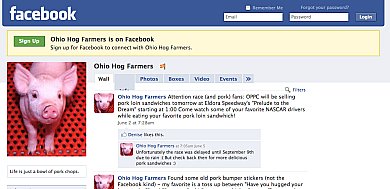(Part I of a two-part series.)
SALEM, Ohio — Are you a fan of Ohio Hog Farmers on Facebook? Have you RT’d Ohio Farm Bureau’s latest tweet yet? Not sure what I’m asking? You might want to start familiarizing yourself with these social networking sites and the related lingo.
Why?
Social networking is a new, effective way to reach consumers, said Jennifer Keller, director of marketing and education at Ohio Pork Producers Council.
“We began our social media efforts in 2007,” Keller said. “We decided we needed to go where the people were.”
The Ohio Pork Producers Council started with a Web site, www.ohioporktour.com, and began posting videos of hog farmers explaining production methods and showing hog facilities.
“Biosecurity is essential to hog operations, so these videos gave producers a way to open up their barn doors to consumers,” Keller said.
Once the Web site was up and running, the council needed a way to drive more people to it.
Keller said in addition to placing advertising on sites such as Google, she considered entering the world of Facebook.
Facebook was founded in 2004 and currently has more than 200 million active users, with 100 million of those users logging onto Facebook daily, according to a Facebook news release.
Not just college kids
More than two-thirds of Facebook users are outside of college networks, and the fastest growing demographic is adults 35 and older.
Keller said this was the demographic the council targeted when they began advertising on Facebook, and the networking site allowed the council to focus their advertising dollars.
The ads appeared on the right side of a user’s profile page. By using different options, the council could place ads only on the pages of grocery buyers in Ohio.
The strategy was successful for the council, so they began looking at other forms of social media.
“That’s when we decided to set up a fan page on Facebook,” Keller said.
Today, the council’s page, “Ohio Hog Farmers,” has nearly 590 “fans,” all Facebook users who can receive updates from the council, comment on videos or photos, or ask a question on the discussion forum.
Twittering
The council’s social media efforts don’t stop at Facebook.
They also set up an account on Twitter, a Web site that enables users to post brief — 140 characters or less — messages that inform fellow users, more commonly known as “followers.”
@OhioHogFarmers, the council’s Twitter handle, has used the site to alert consumers about upcoming promotions and to promote the safety and popularity of pork worldwide.
Hyperlinking
The council’s Facebook page and Twitter profile both link back to the original Web site, Ohio Pork Tour.
“We want people to visit our Pork Tour Web site first, but Facebook and Twitter helps to pull people in,” Keller said. “We’re not abandoning our other forms of advertising — this is just a new one to reach out to consumers.”
More media
One of @OhioHogFarmer’s Twitter followers is the Ohio Farm Bureau (@OhioFarmBureau), the state’s largest farm organization.
The bureau’s social media efforts began in April 2008, said Dan Toland, Ohio Farm Bureau’s communications specialist.
Today, the bureau has more than 700 fans on its Facebook page and more than 1,300 users following its Twitter updates. However, its social media campaign began with a video sharing Web site called YouTube.
YouTube
As of April 2009, YouTube has had about 80 million unique visitors. Ohio Farm Bureau has attempted to attract the attention of these visitors by posting more than 75 videos to the site through two video channels, OurOhio and OhioFarmBureau.
OurOhio is more general and consumer-focused, showcasing how food is produced and processed, and featuring the people behind the product.
This channel’s most popular video, The Amish, has been viewed 24,822 times and received 51 comments.
OhioFarmBureau features clips from Ohio Farm and Country, a joint effort between the bureau and Agri Broadcast Network hosts, Andy Vance and Lindsay Hill.
“By posting these videos on YouTube, we’re giving our messages a longer shelf life,” Toland said. “These videos are searchable and available 24/7.”
New era
Both Keller and Toland believe other agricultural organizations and producers should get involved in social media to get a positive agricultural message out to consumers.
“It’s human nature to be tentative about new things,” Keller said. “Once we had examples, it was easier to get pork producers to be featured in videos. Several of them have started joining Facebook and Twitter to see what’s going on.”
And the more the merrier, said Toland.
“More ag producers and organizations need to be out there, especially with the popularity activist groups have in social media,” he said. “We need to level the playing field.”
Next week: Find out how three ag individuals use social media for networking, direct marketing and job searching.










